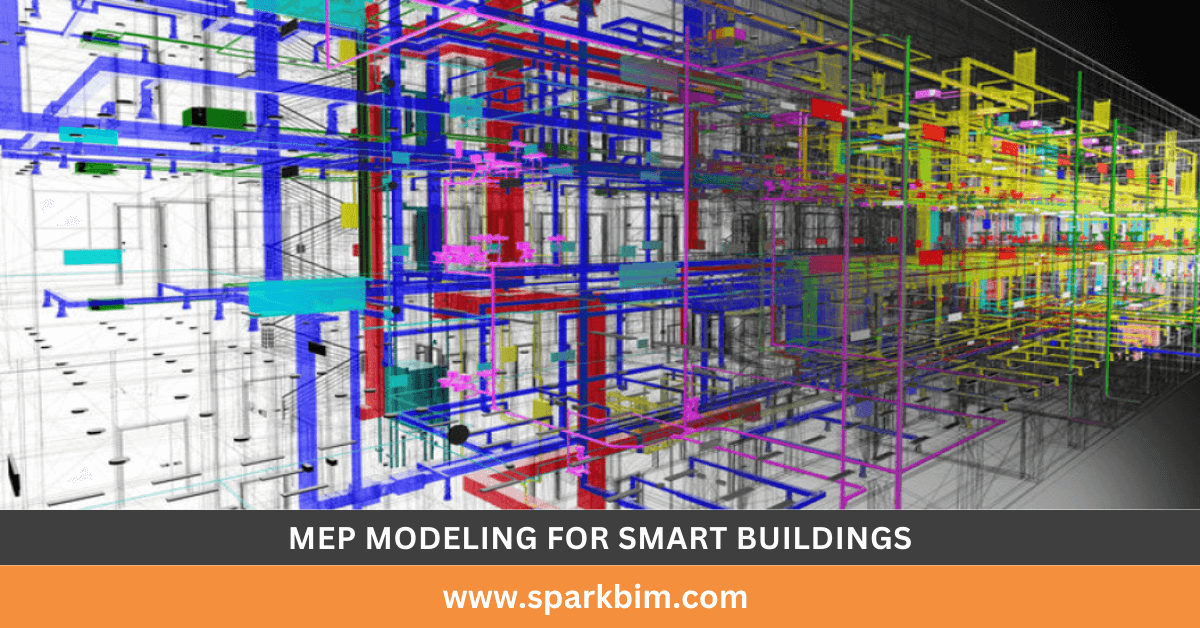In today’s rapidly advancing world of architecture and construction, the integration of technology is more important than ever. One of the game-changing innovations in modern buildings is the concept of “smart buildings.” These buildings utilize cutting-edge technology to enhance efficiency, sustainability, and overall building performance.
One key aspect that drives the functionality of smart buildings is MEP (Mechanical, Electrical, and Plumbing) modeling.
In this blog post, we will explore how BIM MEP Modeling for Smart Buildings can boost automation and control, transforming conventional buildings into futuristic, self-regulating systems.
Understanding MEP Modeling for Smart Buildings
Before diving into the benefits and impacts of MEP modeling on smart buildings, it’s essential to understand what MEP modeling is and how it plays a pivotal role in the construction and operation of modern structures.
MEP modeling refers to the digital representation of the mechanical, electrical, and plumbing systems within a building. It’s a vital component of Building Information Modeling (BIM), a process that involves creating and managing digital models of a building throughout its lifecycle.
Through the use of MEP modeling, engineers, architects, and contractors can design, simulate, and analyze the various systems of a building before actual construction begins.
For smart buildings, MEP modeling goes beyond simple planning and visualization; it enables advanced integration of automation systems, intelligent control mechanisms, and real-time data analysis. These systems can optimize energy consumption, improve occupant comfort, and enhance the building’s overall operational efficiency.
How MEP Modeling Enhances Automation in Smart Buildings
Automation is at the core of a smart building’s functionality, and MEP modeling plays a significant role in enabling this feature. Smart buildings use automated systems to regulate heating, lighting, ventilation, air conditioning (HVAC), and even energy usage. Through MEP modeling, building designers can lay the groundwork for these automated systems to work seamlessly together.
1. Integration of HVAC Systems
One of the primary goals of automation in smart buildings is to optimize energy efficiency and provide consistent comfort to occupants. MEP modeling allows engineers to simulate HVAC systems, ensuring they are properly integrated and automated.
For example, HVAC systems can be programmed to automatically adjust based on factors like occupancy levels, time of day, or external weather conditions. This reduces energy consumption and helps the building maintain a stable indoor environment.
2. Lighting Control Systems
Another significant area where MEP modeling for smart buildings comes into play is lighting. MEP models allow for the precise planning and implementation of automated lighting control systems.
Smart lighting systems adjust the brightness or turn off lights based on room occupancy, natural light levels, or pre-set schedules.
With the integration of MEP modeling, these systems can be optimized to function automatically, reducing energy waste and improving the building’s sustainability.
3. Plumbing Automation
MEP modeling extends to plumbing systems, too. Automated plumbing systems, like water-saving technologies, leak detection sensors, and temperature control systems, can all be effectively planned and simulated using MEP modeling.
These systems can help prevent costly repairs, reduce water consumption, and improve the overall operational efficiency of the building. In a smart building, MEP modeling ensures that these systems are automatically regulated for optimal performance.
Also Read, The Role of Plumbing BIM Modeling in Construction Success
How MEP Modeling Improves Building Control Systems
Building control systems are vital for managing the various subsystems within a smart building, from HVAC and lighting to security and surveillance. These control systems rely on data from sensors and devices spread across the building to make real-time decisions.
MEP modeling for smart buildings provides a comprehensive approach to planning and managing these control systems.
1. Energy Management
One of the most significant advantages of MEP modeling for smart buildings is its ability to optimize energy management. By integrating energy-efficient systems and real-time data monitoring, smart buildings can minimize energy consumption.
MEP models provide a clear roadmap for how energy systems (e.g., lighting, HVAC, and electrical systems) should be connected, controlled, and optimized. These systems can be programmed to function autonomously, adjusting energy use based on the building’s current needs.
2. Building Performance Monitoring
MEP modeling is also crucial for continuous monitoring and control of building performance. Through sensors and smart devices integrated into the MEP model, a smart building can constantly assess parameters such as temperature, humidity, air quality, and energy consumption.
Automated control systems can respond to these inputs by adjusting the building’s mechanical and electrical systems to maintain optimal conditions. This allows for constant optimization and ensures that the building operates at peak efficiency at all times.
3. Smart Security Systems
A smart building’s security system can be fully integrated into its MEP systems. MEP modeling helps plan the electrical and mechanical aspects of security systems, including surveillance cameras, alarms, access control systems, and motion detectors.
These security features can be linked to the building’s automation systems, enabling remote control and real-time monitoring. Through MEP modeling, the building’s security can be automated, providing enhanced safety and peace of mind for occupants.
The Role of MEP Modeling in Sustainability and Efficiency
One of the most significant benefits of MEP modeling for smart buildings is its impact on sustainability and energy efficiency.
As the world becomes more focused on reducing its carbon footprint, smart buildings are leading the way by incorporating green technologies. MEP modeling provides the foundation for implementing these technologies efficiently.
1. Energy Efficiency
By modeling and simulating energy systems in a digital environment, engineers can optimize HVAC systems, lighting controls, and electrical circuits for maximum efficiency.
For instance, MEP modeling can help identify areas where energy waste occurs and suggest improvements, such as the installation of energy-saving devices, the integration of renewable energy sources, or the use of high-efficiency equipment.
2. Water Conservation
Smart buildings can also incorporate water-saving systems into their MEP designs. Automated plumbing systems, such as sensor-based faucets, water leak detectors, and temperature regulation systems, can be planned and optimized through MEP modeling.
These systems help reduce water usage and prevent water-related damage, contributing to a more sustainable building.
3. Indoor Air Quality (IAQ)
The quality of indoor air is a crucial aspect of occupant health and comfort. Through MEP modeling, building designers can integrate advanced HVAC systems that not only regulate temperature but also ensure proper ventilation and air filtration.
Smart buildings can be equipped with sensors that monitor IAQ, adjusting airflow and filtration systems to maintain optimal indoor conditions automatically.
Real-Time Data and Analytics: The Backbone of Smart Building Control
One of the most exciting features of MEP modeling for smart buildings is the ability to collect and analyze real-time data. This data can be used to drive decision-making, optimize building performance, and enhance occupant comfort.
Through integrated sensors, smart devices, and building control systems, real-time data allows for ongoing analysis and adjustments.
1. Predictive Maintenance
By incorporating predictive maintenance into MEP models, building operators can use real-time data to predict when equipment will need servicing or replacement. This reduces downtime and prevents costly repairs, ensuring that building systems operate smoothly.
2. Optimization Algorithms
Advanced algorithms can be employed to analyze data collected from various building systems and optimize their performance.
For example, HVAC systems can be fine-tuned based on occupancy patterns, weather forecasts, and energy consumption data, ensuring that heating and cooling are provided only when needed.
3. User-Centric Control
MEP modeling for smart buildings also enables user-centric control systems. Building occupants can interact with the building’s automation systems through apps or voice commands, giving them control over lighting, temperature, and other settings.
The MEP model ensures that these systems work seamlessly, creating a personalized experience while maintaining overall efficiency.
Also Read, Scan to BIM Solutions for Contractors
Conclusion
MEP modeling plays a crucial role in boosting automation and control. By providing a comprehensive, digital representation of mechanical, electrical, and plumbing systems, MEP modeling ensures that these systems work together seamlessly to enhance building performance, optimize energy consumption, and improve occupant comfort.
Whether it is automating HVAC systems, controlling lighting, or improving water conservation, MEP modeling for smart buildings provides the foundation for efficient, sustainable, and intelligent building operation.
As technology continues to advance, the integration of MEP modeling in the design and operation of smart buildings will only become more essential. It not only supports automation and control but also contributes to the overall sustainability and performance of the building.
For Architects, Engineers, and Building Managers, embracing MEP modeling for smart buildings is no longer just an option – it’s a necessity for staying ahead in the ever-evolving world of smart construction.


